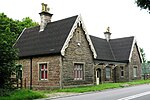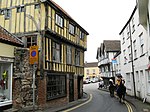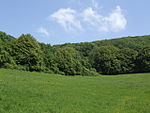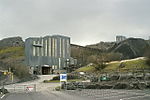King John's Hunting Lodge, Axbridge

King John's Hunting Lodge is a wool-merchant's house built c. 1460, long after the death of King John in 1216, in Axbridge, a town in the English county of Somerset. It is a jettied timber-frame building of three storeys, occupying a corner plot on the town square. The building has served a variety of purposes with shops on the ground floor and workshops and living quarters on the first and second floors. At one time part of the building was occupied by the King's Head Inn; a sculpture of a king's head, which acted as a sign for the pub, is preserved within and a replica is attached to the outside. The lodge was bequeathed to the National Trust in 1971, and repairs were undertaken to reverse significant deterioration to the building. The house is leased by the National Trust to Axbridge and District Museum Trust, who operate it as a local museum which includes exhibits relating to local geology and history from the Neolithic to World War II. It is a Grade II* listed building.
Excerpt from the Wikipedia article King John's Hunting Lodge, Axbridge (License: CC BY-SA 3.0, Authors, Images).King John's Hunting Lodge, Axbridge
The Square, Sedgemoor
Geographical coordinates (GPS) Address Website External links Nearby Places Show on map
Geographical coordinates (GPS)
| Latitude | Longitude |
|---|---|
| N 51.2872 ° | E -2.8176 ° |
Address
King John's Hunting Lodge;King John's Hunting Lodge (Axbridge Museum)
The Square
BS26 2BL Sedgemoor
England, United Kingdom
Open on Google Maps









